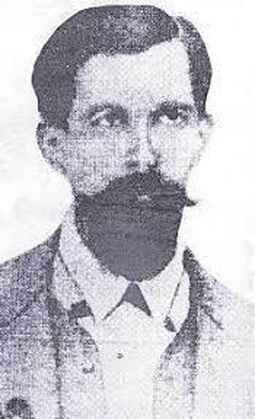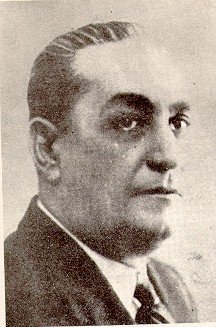
Grito de Lares, also referred to as the Lares revolt, the Lares rebellion, the Lares uprising, or the Lares revolution, was the first of two short-lived revolts against Spanish rule in Puerto Rico, staged by the Revolutionary Committee of Puerto Rico on September 23, 1868. Having been planned, organized, and launched in the mountainous western municipality of Lares, the revolt is known as the Grito de Lares . Three decades after rebelling in Lares, the revolutionary committee carried out a second unsuccessful revolt in the neighboring southwestern municipality of Yauco, known as the Intentona de Yauco. The Grito de Lares flag is recognized as the first flag of Puerto Rico.

Lola Rodríguez de Tió was the first Puerto Rican-born woman poet to establish herself a reputation as a great poet throughout all of Latin America. A believer in women's rights, she was also committed to the abolition of slavery and the independence of Puerto Rico.

Manuel Rojas Luzardo was a Puerto Rican-Venezuelan commander of the Puerto Rican Liberation Army and one of the main leaders of the Grito de Lares uprising against Spanish rule in Puerto Rico.

Alejandrina Benítez de Gautier was a Puerto Rican poet.

Luis Lloréns Torres, was a Puerto Rican poet, playwright, and politician. He was an advocate for the independence of Puerto Rico.

Juan Antonio Corretjer Montes was a Puerto Rican poet, journalist and pro-independence political activist opposing United States rule in Puerto Rico.

María Bibiana Benítez Batista was a Puerto Rican writer who was Puerto Rico's first female poet and one of its first playwrights. She was the first of three renowned poets in her family, the others being her niece and adopted daughter Alejandrina Benítez de Gautier, and Alejandrina's son José Gautier Benítez.

Puerto Rican literature is the body of literature produced by writers of Puerto Rican descent. It evolved from the art of oral storytelling. Written works by the indigenous inhabitants of Puerto Rico were originally prohibited and repressed by the Spanish colonial government.

Clemente Soto Vélez was a Puerto Rican nationalist, poet, journalist and activist who mentored many generations of artists in Puerto Rico and New York City. Upon his death in 1993, he left a rich legacy that contributed to the cultural, social and economic life of Puerto Ricans in New York and Latinos everywhere.

William Miranda Marín was the mayor of Caguas, Puerto Rico, from 1997 until his death in 2010.

The Intentona de Yauco of March 24–26, 1897 was the second and final short-lived revolt against Spanish rule in Puerto Rico. It was staged by the pro-independence Revolutionary Committee of Puerto Rico in the southwestern municipality of Yauco, 29 years after the first unsuccessful revolt, known as the Grito de Lares. During the Intentona de Yauco, the current flag of Puerto Rico was flown on the island for the first time.
Josemilio González (1918–1990) was a Puerto Rican literary critic and editor.

José Gualberto Padilla, also known as El Caribe, was a physician, poet, journalist, politician, and advocate for Puerto Rico's independence. He suffered imprisonment and constant persecution by the Spanish Crown in Puerto Rico because his patriotic verses, social criticism and political ideals were considered a threat to Spanish Colonial rule of the island.

"Lamento Borincano" is Rafael Hernández Marín's acclaimed composition in Puerto Rico's patriotic tradition. It takes its name from the free musical form Lament, and from Borinquen, an indigenous name for the island. Hernández released the song in 1929 to illustrate the economic precariousness that had engulfed the Puerto Rican farmer since the late-1920s' Puerto Rico. It became an instantaneous hit in Puerto Rico and its popularity soon followed in many Latin American countries. Renowned international artists have sung it and featured it in their repertoire.

The flag of Puerto Rico, officially the Flag of the Commonwealth of Puerto Rico, represents Puerto Rico and its people. It consists of five equal horizontal stripes, alternating from red to white, with a blue equilateral triangle based on the hoist side bearing a large, sharp, upright, five-pointed white star in the center. The white star stands for the archipelago and island, the three sides of the triangle for the three branches of the government, the blue for the sky and coastal waters, the red for the blood shed by warriors, and the white for liberty, victory, and peace. The flag is popularly known as the Monoestrellada (Monostarred), meaning having one star, a single star, or a lone star. It is in the Stars and Stripes flag family.

The Gautier Benitez High School, a school named after Puerto Rican poet José Gautier Benítez, was built in 1924 in Caguas, Puerto Rico and is listed on both the U.S. National Register of Historic Places and the Puerto Rico Register of Historic Sites and Zones.

The Grito de Lares flag, most commonly known as the Lares flag, represents the Grito de Lares(Cry of Lares) revolt of 1868, the first of two short-lived rebellions against Spanish rule in Puerto Rico. It consists of a large white Greek cross in the center that extends to all four sides of the flag, dividing it into four equal rectangles, two blue above, the left of which bears a large, sharp, upright, centered, five-pointed white star, and two red below. The white star stands for liberty and freedom, the red rectangles for the blood poured by the heroes of the revolt, and the white cross for the yearning of homeland redemption. Established in the municipality of Lares 27 years before revolutionaries adopted the current flag of Puerto Rico in New York City, the flag of the revolt is recognized as the first flag of the archipelago and island.















